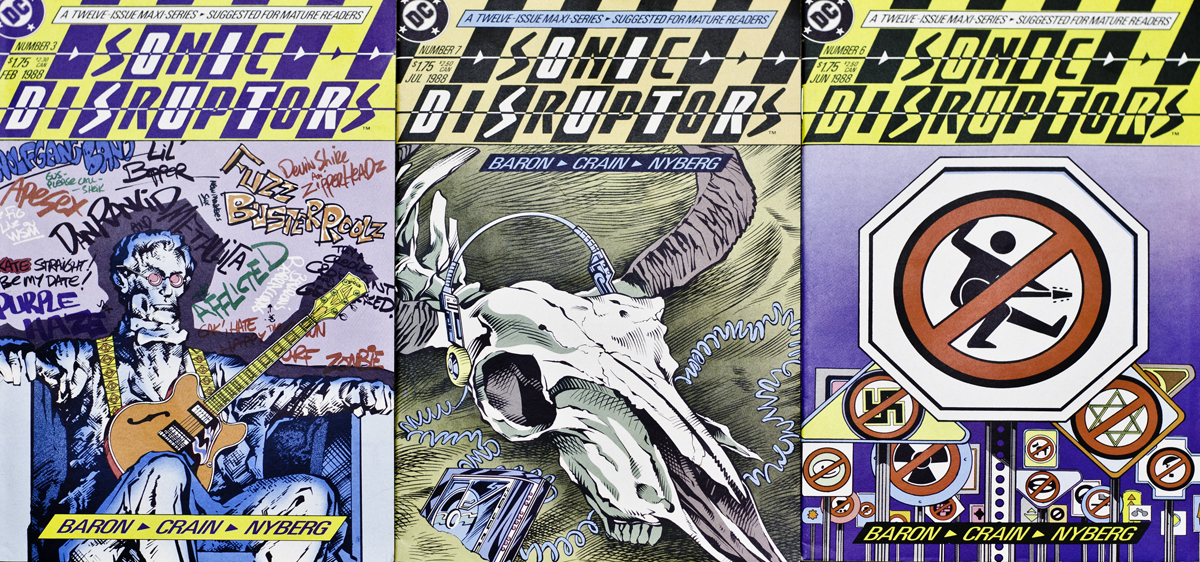Comic Books and Rock & Roll have a complex and entangled relationship, full of shared influences, common history, and thematic cross-pollination. Both started as disposable forms delivered in small doses, became emblematic of youth culture and rebellion in the cold war years, faced endless censorship attempts, and suffered critical reception from dismissive to derisive. Both relied on individual creators but were primarily governed by business concerns – artists providing content for corporations. In comics, the last word belonged to the publishing houses and newsstand distributors; in rock and roll, the record labels and radio stations held similar sway. Both pushed boundaries and developed artistically in the Vietnam era, gaining footholds in the mainstream and infiltrating “cultural” venues where they had previously been shunned. And in the ensuing decades each experienced a series of tiny revolutions, explosions of talent and technique as new generations of creators rose to prominence. Even today, in the monolithic culture of entertainment conglomerates and cross-platform media entities, the two forms have a lingering echo of danger and nonconformity.
And with all this common ground and sensibility, a kinship and connection has grown. Rock music has drawn much inspiration from comics over the years, and vice-versa; comic books regularly interpolate lyrics, utilize musical iconography, and draw on the milieu of rock and roll for subject, setting, and subtext.
Sonic Disruptors is a fine example of the music/comics crossover. It was published by DC Comics in the late 80s and reads today as a time capsule, a hyper-kinetic hallucination born of dissatisfaction with Ronald Reagan’s America, ringing with the influences of college radio, post-punk underground rock, and late-night cable TV. Author Mike Baron was known at the time for his superhero work: co-creating Nexus and writing Marvel’s The Punisher. Sonic Disruptors is a whole different ballgame. Here Baron crafts a crazily winding tale of a satellite-based pirate radio station broadcasting pop music from the skies as an act of defiance against a totalitarian government in a near-future America. The plot jumps off in a few dozen directions, pulling in drug-smuggling, double-crosses, happy coincidences, Chinese army battalions, religious zealots, corrupt lawmakers, television evangelists, and a healthy dose of scorn for authority and politics; not much that happens makes any sense, or even wastes time trying. Barry Crain’s art shifts from nearly photo-realistic to hyper-stylized and cartoony, sometimes within a single panel. It’s a huge beautiful mess: a conduit to a headspinning era of Senate Hearings on obscenity in music, Parental Advisory labels, cold war propaganda, acid-washed jeans, and Night Flight broadcasts. It’s one of the strangest things I’ve ever read from one of the two major comic companies, and it was a notorious flop upon release. Intended to be a twelve-part series, it was cancelled abruptly after the seventh issue – the story left hanging in midair, never to be completed.
Full of passion and mad ideas, Sonic Disruptors is the comics equivalent of a midnight movie: a deeply flawed but thrilling read. For all the dystopian future trappings, it captures with absolute clarity the feeling of a connection to (and passion for) music.
Sonic Disruptors was published by DC Comics in 1987/1988, and is highly recommended for any fan of Tank Girl, American Flagg, Buckaroo Banzai, Repo Man, and other strange things. The series has never been collected or reprinted, but original issues can be found inexpensively on Ebay or (better still) at your local comic shop.
All articles in the Pop Music Comics series can be found here.


Awesome. I love the idea of comics and music sharing inspiration, ideas, cultural ideology. That’s one of those things you don’t necessarily think about until someone points it out. Then it seems so obvious you forget that someone had to point it out…